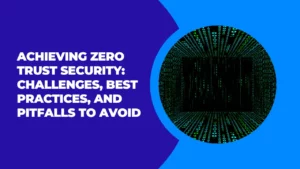Physical Address
304 North Cardinal St.
Dorchester Center, MA 02124
Physical Address
304 North Cardinal St.
Dorchester Center, MA 02124

In today’s digital age, the need for secure data protection has never been more critical. With cyber attacks becoming more sophisticated and frequent, traditional security measures have proven to be inadequate.
That’s where Zero Trust Security comes in. In this blog, we will dive deep into the concept of Zero Trust Security. We’ll explore its origin and evolution, key principles, and how it works. We’ll explain why implementing a Zero Trust Security model is essential for protecting your company’s sensitive information from malicious attackers.
Additionally, we’ll discuss common misconceptions about Zero Trust and the components crucial for successfully implementing it. Lastly, we’ll examine the benefits of adopting a Zero Trust architecture while highlighting some potential pitfalls to avoid. Join us as we explore the future of secure data protection with Zero Trust Security!

Zero Trust Security is a revolutionary approach that eliminates implicit trust in any entity. By challenging the traditional network perimeter approach, it focuses on securing access to resources based on user identity.
This means continuous verification and strict access controls are required. The goal is to reduce the attack surface and prevent lateral movement within an organization’s network. Implementing a zero trust solution requires security teams to prioritize user access, data security, and threat prevention.
By incorporating a zero trust model into the security framework, organizations can safeguard their intellectual property, customer data, and enterprise data. This approach replaces the traditional approach of relying on a virtual private network (VPN) or private network for device access.
It provides a more robust and comprehensive security strategy against malicious actors. With a zero trust maturity model in place, organizations can ensure the integrity and confidentiality of their information systems.
The concept of Zero Trust was introduced by Forrester Research analyst John Kindervag, and it has since evolved from a network security model to a comprehensive security strategy.
The rise of cloud services and remote access has fueled the adoption of Zero Trust, as organizations recognize the need for a more holistic approach to security. This shift has been driven by the increasing number of data breaches, which have highlighted the vulnerabilities of traditional security approaches.
Notably, federal agencies in the United States have embraced the Zero Trust approach, acknowledging its effectiveness in protecting against malicious actors. By implementing Zero Trust, organizations can establish a trust network architecture that prioritizes user access based on identity rather than relying solely on the security of the private network. This zero trust model enhances data security, secures intellectual property, and mitigates the risk of unauthorized data access.
The key principles of the Zero Trust model revolve around the concept of least privilege access, continuous monitoring and threat intelligence, mutual authentication, and device identity, a holistic approach to security, and the incorporation of secure access service edge (SASE) to protect the entire network.
By operating on the principle of least privilege access, the Zero Trust model ensures that users are granted only the necessary permissions to perform their tasks, reducing the risk of unauthorized access.
Continuous monitoring and threat intelligence play a crucial role in identifying and mitigating potential threats in real time. Mutual authentication and device identity enhance the security of user access by verifying the authenticity of both the user and the device.
Embracing a holistic approach, the Zero Trust model considers the integration of people, processes, and technology to create a comprehensive security framework.
Lastly, the adoption of a secure access service edge (SASE) helps safeguard the organization’s network by combining network security functions and cloud security services into a single cohesive solution.
In the context of Zero Trust, the focus shifts from network location to user identity. User identity serves as the cornerstone for implementing effective Zero Trust security policies. Authentication and authorization of users are crucial components of Zero Trust, ensuring that only authorized users are granted access.
Zero Trust Network Access (ZTNA) solutions enhance user experience by providing secure access to sensitive information based on user identity. By prioritizing user identity, organizations can ensure data security and protect intellectual property.
Implementing a zero trust strategy enables security teams to adopt a proactive approach to protecting an organization’s network and mitigating potential threats from malicious actors. Zero Trust, as a security model, revolutionizes the traditional approach to security by emphasizing the importance of user identity and data access control.
Traditional security approaches no longer suffice against advanced threats. Zero Trust, a model that emphasizes user access and revamps the traditional approach to security, is crucial in preventing data breaches and safeguarding valuable resources.
Implementing Zero Trust strategies fortifies an organization’s security posture and aids in meeting regulatory compliance requirements.
Moreover, Zero Trust supports digital transformation initiatives and enables secure remote access to an organization’s network. By incorporating a zero trust security model, organizations can enhance data security, protect intellectual property and enterprise data, and mitigate the risk of malicious actors infiltrating information systems.
Embracing a Zero Trust enterprise maturity model ensures threat prevention, device access control, and the protection of customer data without relying solely on a traditional security framework.
In the Zero Trust model, trust is no longer based on network location but on user identity and device integrity. This approach challenges the assumption that trusted entities within the network are inherently safe. Instead of focusing on securing the network perimeter, Zero Trust emphasizes securing individual users and devices.
With Zero Trust, trust is established and verified at every access request, ensuring that only authenticated users are granted access to resources. By shifting the focus from network location to user identity, organizations can better protect their data and intellectual property.
Zero Trust also helps in preventing data breaches and meeting regulatory compliance requirements. This new security strategy enhances an organization’s overall security posture and supports secure remote access.
Zero Trust Security works on the principle of “never trust, always verify.” It enforces strict access controls and authentication mechanisms to protect sensitive data.
A zero trust security architecture is used, along with a zero trust platform that monitors and detects malicious activities. Continuous verification is key to preventing insider threats and compromised devices.
Zero Trust is often misunderstood to imply zero usability or hinder user productivity. However, that’s not the case. Zero Trust security model emphasizes the need for user access controls and authentication mechanisms while ensuring a smooth workflow.
Another misconception is that implementing Zero Trust requires a complete overhaul of existing infrastructure. In reality, it can be integrated gradually into an organization’s network architecture, leveraging existing systems with added security features.
Zero Trust also goes beyond addressing external threats; it encompasses insider threats as well. Additionally, Zero Trust is not a one-size-fits-all approach. It can be tailored to meet the specific needs of an organization.
It’s important to note that Zero Trust isn’t solely focused on technology; it also involves people and processes. By adopting a Zero Trust strategy, organizations can enhance their cloud security, data security, and overall threat prevention capabilities.
Robust access management and policy enforcement are essential components of implementing the zero trust model. By strictly controlling user access to sensitive data and resources, organizations can minimize the risk of unauthorized access and potential breaches.
Network segmentation is another crucial aspect of zero trust security, as it divides the organization’s network into smaller, isolated segments to prevent lateral movement by malicious actors. Secure authentication mechanisms, such as multi-factor authentication and biometric verification, play a critical role in ensuring that only authorized users can gain access to the network.
Zero trust also requires the integration of threat intelligence and continuous monitoring to detect and respond to potential threats in real time. Additionally, encrypted communications help safeguard data transmitted across the network, adding an extra layer of protection to the overall zero trust security architecture.
Achieving a robust security posture is crucial for organizations in today’s threat landscape. The Zero Trust approach is instrumental in reducing the risk of data breaches and cyberattacks. By implementing a Zero Trust security model, organizations can limit lateral movement within the network, making it challenging for attackers to compromise critical assets. This architecture enhances visibility, enabling security teams to detect and respond rapidly to security incidents.
In a Zero Trust network, users access resources on a need-to-know basis, ensuring that only authorized individuals can gain entry. This user access control helps safeguard sensitive information, including intellectual property and customer data. Additionally, the Zero Trust strategy protects against supply chain attacks, defending the organization’s network from potential malicious actors.
By embracing a Zero Trust security framework, organizations can strengthen their security operations, fortify their data security, and mitigate the risks posed by both external and insider threats. This comprehensive approach to network trust empowers organizations to defend against evolving cyber threats and secure their critical assets effectively.
Benefits of adopting a zero trust architecture include improved network security, reduced risk of lateral movement within the network, constant verification of user identity for secure access, enhanced data protection in the era of digital transformation, and a move away from implicit trust to a more secure access model.
Implementing a zero trust model revolutionizes access control by eliminating the reliance on a traditional network perimeter. Instead of assuming implicit trust, this security approach requires strict access policies and continuous verification to ensure secure user access.
With a zero trust architecture, organizations can confidently provide secure access to cloud services and IoT devices, safeguarding their data from potential threats. By reducing the need for implicit trust, this approach also reduces IT complexity, streamlining operations and making it easier for security teams to manage access controls.
This enhanced security posture is achieved through the implementation of the principle of least privilege access, ensuring that users only have access to the resources they truly need. By adopting a zero trust strategy, organizations can enhance their data security, protect intellectual property, and strengthen their overall security framework.
One pitfall to steer clear of is implementing a zero trust strategy without a comprehensive understanding of the organization’s network infrastructure. It is crucial to have a clear picture of the network layout and architecture before diving into a zero trust implementation.
Another common pitfall is solely relying on advanced technology without considering the human factor in security. While technology plays a crucial role, it is equally important to educate and train security teams and users about zero trust principles.
Proper planning and effective communication are essential to avoid user resistance and ensure the smooth adoption of the zero trust model. Continuous monitoring and updating of security policies are vital to maintaining the effectiveness of the zero trust solution. Lastly, integrating zero trust with existing security tools and practices is crucial to avoid creating gaps in the overall security posture.
Zero trust security is gaining traction as organizations recognize the limitations of traditional approaches. The executive order mandating its adoption by US federal agencies highlights its importance.
Zero trust mitigates insider threats and protects against breaches in a remote and cloud-based landscape. It aligns with continuous verification, adapting to evolving threats and technologies.
In conclusion, implementing a Zero Trust Security model is essential in today’s digital landscape to protect sensitive data and systems from cyber threats. By adopting the key principles of Zero Trust, such as identity-based trust and redefining trust from network location to identity, organizations can create a more secure environment.
It is crucial to understand how Zero Trust works and debunk any misconceptions about it. Components like ensuring network trust and thwarting malicious attacks play a significant role in implementing Zero Trust.
The benefits of adopting a Zero Trust architecture include providing secure access and reducing IT complexity. However, organizations should be cautious of pitfalls while implementing Zero Trust. With its ability to enhance data protection and security, Zero Trust Security holds great promise for the future.